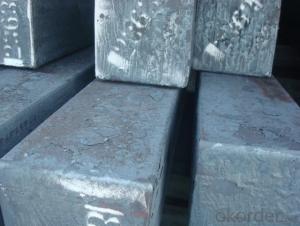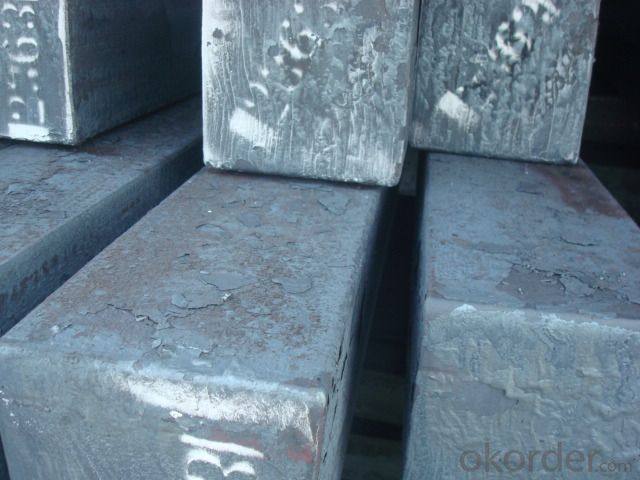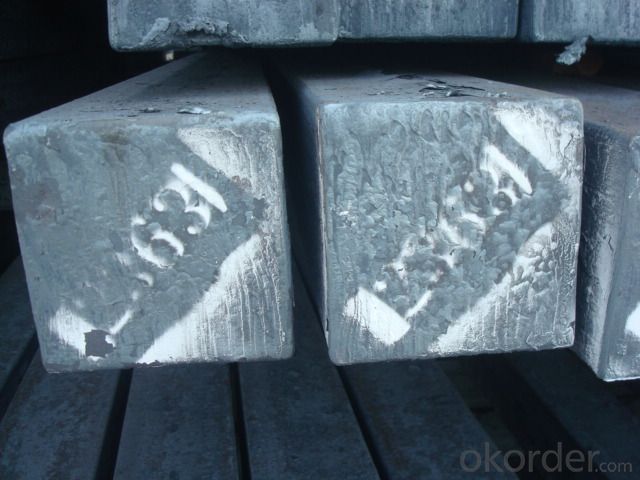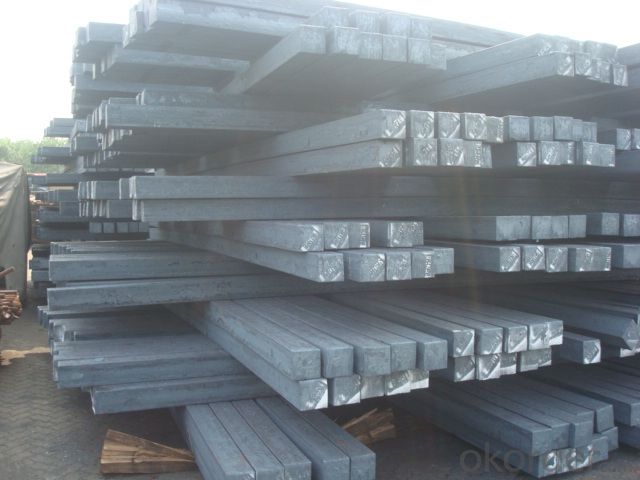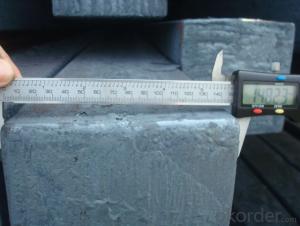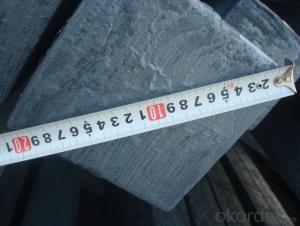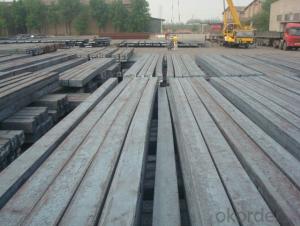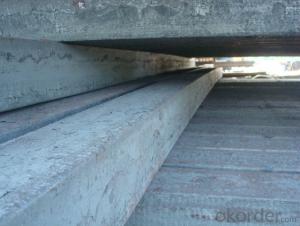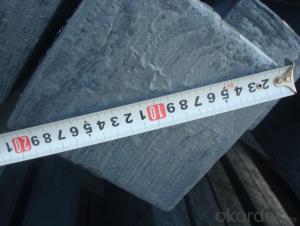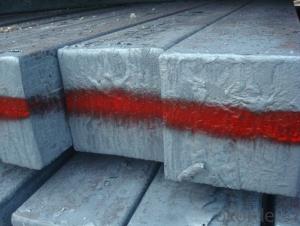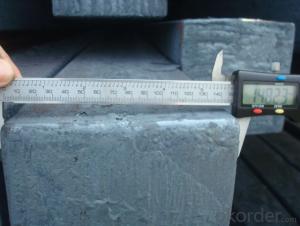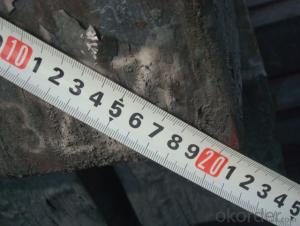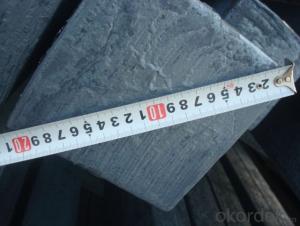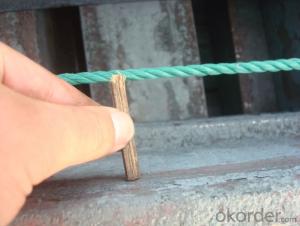Steel Billet Hot Rolled Q235 in Amazing Price
- Loading Port:
- Tianjin
- Payment Terms:
- TT OR LC
- Min Order Qty:
- 1000 m.t.
- Supply Capability:
- 50000 m.t./month
OKorder Service Pledge
OKorder Financial Service
You Might Also Like
1.Structure of Steel Billet
Steel billet(ingot) by cogging or breakdown of semi-finished products, is the raw material of all kinds of steel mill. Billet section of square, round, flat, rectangular and abnormity of several kinds of, mainly related to the shape of rolled products.
2.Main Features of Steel Billet
Rectangular billet continuous casting billet and mainly general carbon steel, low carbon low silicon cold-rolled material, high quality carbon structural steel, high strength low alloy steel, special steel, etc.
The billet is mainly divided into two kinds from the shape:
Slab: cross section width and height of the ratio of the larger, mainly used for rolling plate.
Billet: equal cross section width and height, or a huge difference, mainly used for rolling steel, wire rod. ,
Steel billets have distinct characteristics as compared with already furnished steel bars and products. Billets have a specific grain structure, which enables the metal to be processed more intricately. Steel billets are also known for their malleability and ductility, especially when exposed to varying temperatures during shaping and molding.
3.Steel Billet Images
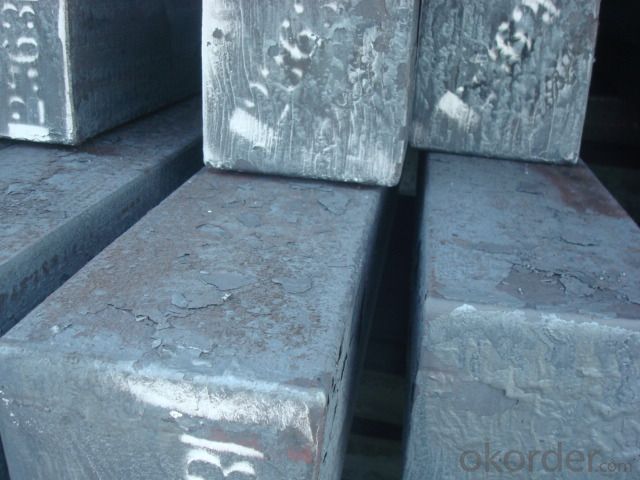
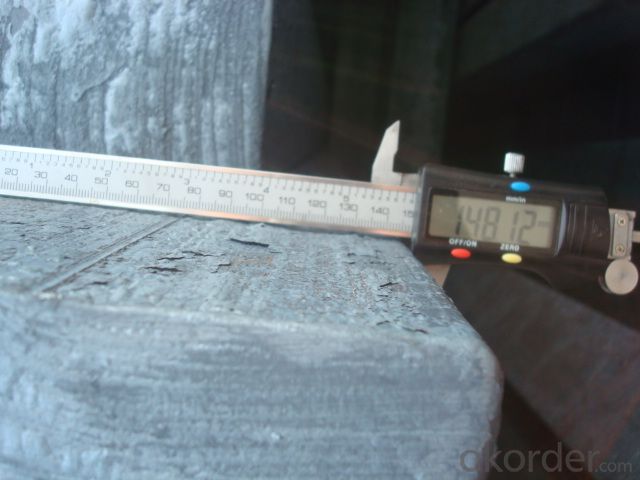
4. Steel Billet Specification
Hot rolled billet steel
Size: 50x50mm-180x180mm
Steel Grade: 3SP, 5SP,Q195,Q235,Q255,Q275 Length:3m-12m
MOQ: 1000MT/size
Payment term: TT or LC
Packing: in bulk , bundle
Shipment: by container , bulk vessel
Packaging Details: bundles with steel strips or as customers's requirements
Delivery time: 15-30 days after the deposit
Loading port:Tianjin, or other port China
Origin :China
Inspection:Third party inspection before loading.
5.FAQ
We have organized several common questions for our clients,may help you sincerely:
1) How about your company?
A world class manufacturer & supplier of castings forging in carbon steel and alloy steel,is one of the large-scale professional investment casting production bases in China,consisting of both casting foundry forging and machining factory. Annually more than 8000 tons Precision casting and forging parts are exported to markets in Europe,America and Japan. OEM casting and forging service available according to customer’s requirements.
2) How to guarantee the quality of the products?
We have established the international advanced quality management system,every link from raw material to final product we have strict quality test;We resolutely put an end to unqualified products flowing into the market. At the same time, we will provide necessary follow-up service assurance.
3) How long can we receive the product after purchase?
In the purchase of product within three working days, We will arrange the factory delivery as soon as possible. The pecific time of receiving is related to the state and position of customers.Commonly 7 to 10 working days can be served.
4)I want to buy products, but I can’t find them in your website.
We have some products not listed on the website. If you can’t see what you are looking for, email us and we will work with you to get you what you want.
How about the guaranty for your products?
A: It depends on the working environment. Generally speaking, the guarantee period for safety shoes is 6 months.
- Q: How do steel billets contribute to the manufacturing of machinery and equipment?
- The role of steel billets in the manufacturing of machinery and equipment is crucial. These semi-finished steel products serve as raw materials in various manufacturing processes. A primary contribution of steel billets to machinery and equipment manufacturing lies in the production of steel bars and rods. These shapes, essential components in the construction of machinery and equipment, are created by heating and then rolling or forging steel billets. Steel bars and rods provide strength, durability, and stability to machine structures. Additionally, steel billets are utilized in the production of other steel components such as gears, crankshafts, and axles. These components are vital for the proper functioning of machinery and equipment, requiring the high strength and toughness offered by steel billets. Manufacturers can rely on steel billets to ensure their machinery and equipment can withstand heavy loads, vibrations, and other demanding conditions. Furthermore, steel billets are commonly employed in the production of steel pipes and tubes, which find widespread use across various industries. These pipes and tubes are essential for transporting fluids, gases, and other materials within machinery and equipment. By utilizing steel billets, manufacturers can create pipes and tubes that not only possess strength and durability but also resist corrosion and wear. Moreover, steel billets contribute to machinery and equipment manufacturing by enabling the production of precision-engineered components. Manufacturers can machine, drill, and shape these billets to meet the specific requirements of different machinery and equipment. This flexibility allows manufacturers to produce intricate and complex components necessary for the efficient operation of machines. Overall, steel billets are integral to the machinery and equipment manufacturing process. They provide the necessary strength, durability, and versatility required to produce components capable of withstanding the demanding conditions of industrial applications. Without steel billets, the manufacturing industry would face difficulties in producing reliable, efficient, and long-lasting machinery and equipment.
- Q: How are steel billets used in the manufacturing of power generation equipment?
- Steel billets are used in the manufacturing of power generation equipment as they serve as the starting material for various components such as turbine blades, rotors, casings, and shafts. These billets are shaped, machined, and heat-treated to meet the specific requirements of the equipment, ensuring high strength, durability, and resistance to extreme operating conditions.
- Q: How are steel billets preheated before processing?
- Steel billets are typically preheated before processing using a variety of methods such as induction heating, gas-fired furnaces, or electric resistance heating. These techniques raise the temperature of the billets to an optimal level, ensuring they are ready for further processing, such as rolling or forging.
- Q: What are the different methods of steel billet surface cleaning?
- There are several methods of steel billet surface cleaning, each with its own advantages and disadvantages. Some of the common methods include: 1. Shot Blasting: This method involves shooting small metallic or non-metallic particles at high velocity onto the surface of the billet. The impact of these particles removes any rust, scale, or surface contaminants. Shot blasting is an effective method for cleaning large surfaces quickly, but it can cause surface roughness and may not be suitable for all types of steel. 2. Acid Pickling: Acid pickling involves immersing the steel billet in an acid solution, typically hydrochloric or sulfuric acid, to remove scale and rust. The acid reacts with the surface contaminants, dissolving them and leaving a clean surface. Acid pickling is effective in removing stubborn scale and rust, but it requires careful handling of the corrosive acids and proper disposal of the waste. 3. Mechanical Cleaning: Mechanical cleaning methods involve using abrasive tools or brushes to physically scrub the surface of the billet. This can be done manually or using machinery. Mechanical cleaning is effective in removing loose contaminants and scale, but it may not be suitable for heavily rusted or stubbornly adhered contaminants. 4. High-Pressure Water Jetting: This method uses high-pressure water jets to clean the surface of the billet. The force of the water removes scale, rust, and other contaminants. High-pressure water jetting is environmentally friendly as it does not involve the use of chemicals, but it may not be as effective in removing heavy scale or rust. 5. Ultrasonic Cleaning: Ultrasonic cleaning involves immersing the steel billet in a tank filled with a cleaning solution and subjecting it to high-frequency ultrasonic vibrations. The vibrations create tiny bubbles in the cleaning solution, which implode on the surface of the billet, effectively removing contaminants. Ultrasonic cleaning is effective in removing even microscopic particles and can reach complex geometries, but it may not be suitable for large-scale cleaning operations. Each of these methods has its own strengths and limitations, and the choice of method depends on factors such as the type and condition of the surface contaminants, the time and cost constraints, and the desired surface finish.
- Q: How are steel billets used in the production of gear blanks?
- Steel billets are an essential component in the production of gear blanks. Gear blanks are the starting point for the manufacturing of gears. They are essentially the raw, unfinished pieces that will later be shaped and transformed into the final gear product. Steel billets, which are long, rectangular bars of steel, provide the necessary material for the creation of gear blanks. These billets are typically made from high-quality steel that possesses the required strength, durability, and machinability characteristics needed for gear production. To create gear blanks, the steel billets are first heated to a specific temperature to make them more malleable and easier to shape. The heated billets are then subjected to various forming processes, such as forging or extrusion, to transform them into the desired shape of the gear blank. Once the gear blank is formed, it undergoes further machining processes to refine its shape, dimensions, and surface finish. This may include operations such as turning, milling, drilling, or grinding. The precise machining ensures that the gear blank meets the required specifications for the final gear product. The gear blanks produced from steel billets serve as the foundation for the creation of various types of gears, such as spur gears, helical gears, bevel gears, or worm gears. These gear blanks undergo additional steps, such as heat treatment and surface hardening, to enhance their mechanical properties and increase their resistance to wear and fatigue. In summary, steel billets are integral to the production of gear blanks as they provide the raw material from which gears are formed. Through a series of heating, forming, and machining processes, the steel billets are transformed into gear blanks, which are then further processed to create the final gears used in various applications.
- Q: What are the potential risks associated with steel billet production?
- Steel billet production carries various potential risks. To begin with, the production process involves working with high temperatures and molten metal, which can lead to burns and fire hazards. Operators and workers must exercise caution when handling the equipment and ensure they follow proper safety protocols to prevent accidents. Moreover, the raw materials used in steel billet production, such as iron ore and coal, may contain impurities that can release harmful gases and particulate matter during production. If not controlled and mitigated effectively, these emissions can pose health risks to workers and nearby communities. In addition, the machinery and equipment utilized in steel billet production, including furnaces and rolling mills, can pose mechanical hazards if not adequately maintained or operated. Accidents resulting from equipment malfunctions or material failures can cause injuries to workers and damage to the production facility. Furthermore, the steel industry heavily relies on non-renewable energy sources, such as electricity and fossil fuels, which contribute to greenhouse gas emissions and climate change. It is essential to minimize the environmental impact by implementing energy-efficient practices and adopting cleaner technologies. Lastly, transporting steel billets from the production facility to the next stage in the supply chain presents risks. Proper lifting and securing techniques are necessary to prevent accidents and injuries during loading, unloading, and transportation of the heavy steel billets. To address these risks, steel billet producers must prioritize safety measures. This includes conducting regular equipment inspections, providing proper training for workers, implementing environmental controls, adhering to safety regulations, and continuously improving operational practices.
- Q: How are steel billets inspected for surface cleanliness?
- Steel billets are inspected for surface cleanliness through visual inspection, where trained inspectors carefully examine the billets for any visible dirt, oxide scale, or other contaminants. Additionally, surface cleanliness can also be tested using methods like magnetic particle testing or ultrasonic testing to detect any hidden defects or impurities.
- Q: Can steel billets be used for artistic purposes?
- Yes, steel billets can certainly be used for artistic purposes. While steel billets are typically used as raw material in industrial applications such as construction or manufacturing, they can also be transformed into beautiful works of art. Artists often use steel billets to create sculptures, decorative pieces, or even functional objects like furniture. The versatility of steel allows artists to mold and shape it into various forms, while its strength and durability ensure the longevity of the artwork. Moreover, the metallic appearance of steel can add a modern and industrial aesthetic to artistic creations. Overall, steel billets offer artists a unique medium to express their creativity and create visually stunning pieces.
- Q: Charcoal is how to
- Usually we measure the quality of charcoal mainly from the moisture content, volatile content, ash content, fixed carbon content and calorific value of charcoalTake it, thanks!!
- Q: What are the different types of heat treatment processes used for steel billets?
- There are several different types of heat treatment processes used for steel billets. Some commonly used methods include annealing, normalizing, quenching and tempering, and case hardening. Each process has its own purpose and is used to achieve specific properties in the steel billets.
Send your message to us
Steel Billet Hot Rolled Q235 in Amazing Price
- Loading Port:
- Tianjin
- Payment Terms:
- TT OR LC
- Min Order Qty:
- 1000 m.t.
- Supply Capability:
- 50000 m.t./month
OKorder Service Pledge
OKorder Financial Service
Similar products
Hot products
Hot Searches
Related keywords
